Power Pitch
Pitch: Deep Learning Image Reconstruction
ISMRM & ISMRT Annual Meeting & Exhibition • 03-08 June 2023 • Toronto, ON, Canada

08:15 |
0819.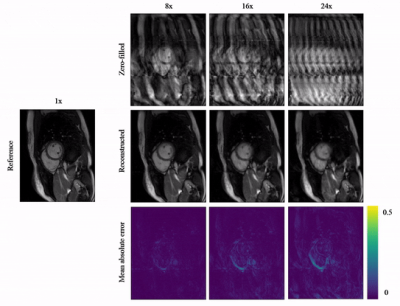 |
Attention mechanisms for sharing low-rank, image and k-space
information during MR image reconstruction
Siying Xu1,
Kerstin Hammernik2,3,
Patrick Krumm1,
Sergios Gatidis1,4,
and Thomas Küstner1
1Medical Image and Data Analysis (MIDAS.lab), Department of Diagnostic and Interventional Radiology, University Hospital of Tuebingen, Tuebingen, Germany, 2Lab for AI in Medcine, Technical University of Munich, Munich, Germany, 3Department of Computing, Imperial College London, London, United Kingdom, 4Max Planck Institute for Intelligent Systems, Tuebingen, Germany Keywords: Image Reconstruction, Machine Learning/Artificial Intelligence, Image Reconstruction, Heart Cardiac CINE MR imaging requires long acquisitions under multiple breath-holds. With the development of deep learning-based reconstruction methods, the acceleration rate and reconstructed image quality have been increased. However, existing methods face several shortcomings, such as limited information-sharing across domains and generalizability which may restrict their clinical adoption. To address these issues, we propose A-LIKNet which incorporates attention mechanisms and maximizes information sharing between low-rank, image, and k-space in an interleaved architecture. Results indicate that the proposed A-LIKNet outperforms other methods for up to 24x accelerated acquisitions within a single breath-hold. |
08:15 |
0820. |
IMJENSE: scan-specific IMplicit representation for Joint
coil sENSitivity and image Estimation in parallel MRI
Ruimin Feng1,
Qing Wu2,
Yuyao Zhang2,
and Hongjiang Wei1
1School of Biomedical Engineering, Shanghai Jiao Tong University, Shanghai, China, 2School of Information Science and Technology, ShanghaiTech University, Shanghai, China Keywords: Image Reconstruction, Machine Learning/Artificial Intelligence, implicit neural representation Current parallel imaging techniques for MRI acceleration can still not reliably reconstruct a high-quality image from highly reduced k-space measurements with fewer calibration data. In this study, we applied the new insight of implicit neural representation (INR) to parallel MRI reconstruction. The underlying MRI image and coil sensitivities were modeled as continuous functions of spatial coordinates. These functions were simultaneously learned from the sparsely-acquired k-space itself without additional training data. Thanks to the continuous representation and joint estimation scheme, the proposed method outperforms the existing scan-specific methods, demonstrating its potential for further accelerating the MRI acquisition. |
| 08:15 |
0821.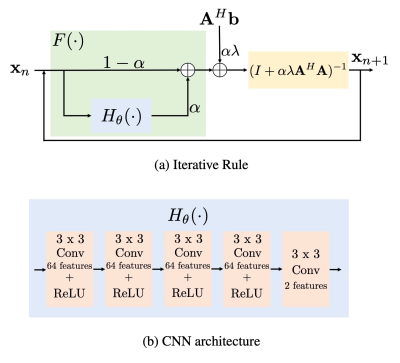 |
Monotone Operator Learning: a robust and memory-efficient
physics-guided deep learning framework
Aniket Pramanik1 and
Mathews Jacob1
1Electrical and Computer Engineering, University of Iowa, Iowa City, IA, United States Keywords: Image Reconstruction, Machine Learning/Artificial Intelligence MRI has been revolutionized by compressed sensing algorithms, which offer guaranteed uniqueness, convergence, and stability. In the recent years, model-based deep learning methods have been emerging as more powerful alternatives for image recovery. The main focus of this paper is to introduce a model based algorithm with similar theoretical guarantees as CS methods. The proposed deep equilibrium formulation is significantly more memory-efficient than unrolled methods, which allows us to apply it to 3D or 2D+time problems that current unrolled algorithms cannot handle. Our results also show that the approach is more robust to input perturbations than current unrolled methods. |
| 08:15 |
0822.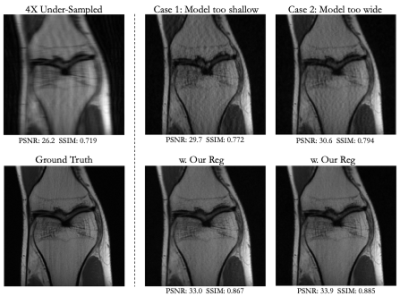 |
Architecture-agnostic Deep Image Prior for Accelerated MRI
reconstruction
Yilin Liu1,
Yong Chen2,
and Pew-thian Yap3
1Department of Computer Science, University of North Carolina at Chapel Hill, Chapel Hill, NC, United States, 2Department of Radiology, Case Western Reserve University, Cleveland, OH, United States, 3Department of Radiology, University of North Carolina at Chapel Hill, Chapel Hill, NC, United States Keywords: Image Reconstruction, Machine Learning/Artificial Intelligence This work aims to simplify deep image prior (DIP) architectural design decisions in the context of unsupervised accelerated MRI reconstruction, facilitating the deployment of MRI-DIP in real-world settings. We first show that architectures inappropriate for specific MRI datasets (knee, brain) can lead to severe reconstruction artifacts, and then demonstrate that proper network regularization can dramatically improve image quality irrespective of network architectures. The proposed plug-and-play regularization is applicable to any network form without architectural modifications. |
| 08:15 |
0823.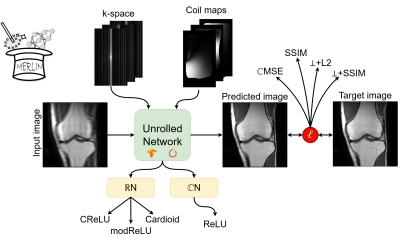 |
MERLIN: In-depth investigation on complex-valued image
reconstruction in PyTorch and Tensorflow
Maarten Terpstra1,2,
Kerstin Hammernik3,4,
Thomas Küstner5,
Matteo Maspero1,2,
Cornelis van den Berg1,2,
and Daniel Rueckert3,4
1Department of Radiotherapy, University Medical Center Utrecht, Utrecht, Netherlands, 2Computational Imaging Group for MR Diagnostics & Therapy, University Medical Center Utrecht, Utrecht, Netherlands, 3Lab for AI in Medcine, Technical University of Munich, Munich, Germany, 4Department of Computing, Imperial College London, London, United Kingdom, 5Medical Image And Data Analysis (MIDAS.lab), University Hospital of Tübingen, Tübingen, Germany Keywords: Image Reconstruction, Machine Learning/Artificial Intelligence Machine learning (ML) has become a powerful technique for reconstructing undersampled MRI. However, applying ML to MRI reconstruction requires several essential building blocks, consisting of general operations and MRI-specific operators in the context of reconstruction. While the former are available in generic frameworks such as Keras/TensorFlow or PyTorch, the MR-specific operators are generally custom-implemented. MERLIN was proposed as a generic toolkit for ML-based medical imaging to harmonize the machine learning landscape and to provide complex-valued interfaces for commonly used back-ends. Here, we evaluate MERLIN as a cross-platform toolkit for complex-valued image reconstruction. |
| 08:15 |
0824.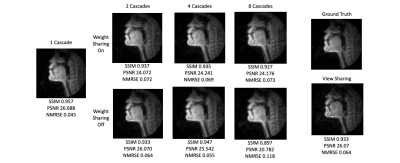 |
Real-time deep learning non-Cartesian image reconstruction
using a causal variational network
Prakash Kumar1 and
Krishna S Nayak1
1Ming Hsieh Department of Electrical and Computer Engineering, University of Southern California, Los Angeles, CA, United States Keywords: Image Reconstruction, Machine Learning/Artificial Intelligence, Real-Time Real-time MRI captures movements and dynamic processes in human body without reliance on any repetition or synchronization. Many applications require low-latency (typically <200ms) for guidance of interventions or closed-loop feedback. Standard constrained optimization methods are too slow to be implemented “online”. We demonstrate a non-Cartesian deep learning image reconstruction method based on the end-to-end variational network. Training data are created using traditional high latency compressed sensing reconstruction as the reference, with the goal of achieving similar results with low latency. We demonstrate reconstruction latencies of 95ms per frame, with nRMSE of 0.045 and SSIM of 0.95. |
| 08:15 |
0825.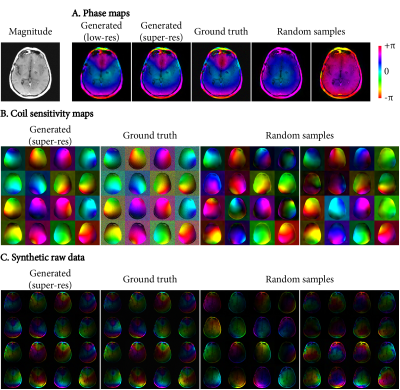 |
Deep-learning-based transformation of magnitude images to
synthetic raw data for deep-learning-based image
reconstruction
Frank Zijlstra1,2 and
Peter T While1,2
1Department of Radiology and Nuclear Medicine, St. Olav's University Hospital, Trondheim, Norway, 2Department of Circulation and Medical Imaging, NTNU - Norwegian University of Science and Technology, Trondheim, Norway Keywords: Image Reconstruction, Machine Learning/Artificial Intelligence, synthetic data, compressed sensing, accelerated imaging This study demonstrates using generative deep learning for transforming magnitude-only images into synthetic raw data for deep-learning-base image reconstruction. Using relatively few raw datasets, a set of neural networks was trained to generate the missing phase and coil sensitivity information in magnitude-only images. These maps are then recombined into synthetic raw data. We trained end-to-end variational networks for 4-fold accelerated compressed sensing reconstruction on the FastMRI dataset, with increasing training set size. Synthetic raw data showed similar improvements as real raw data with increasing data. This shows promise for applying deep-learning-based image reconstruction when raw data is scarce. |
| 08:15 | 0826. | WITHDRAWN |
| 08:15 |
0827.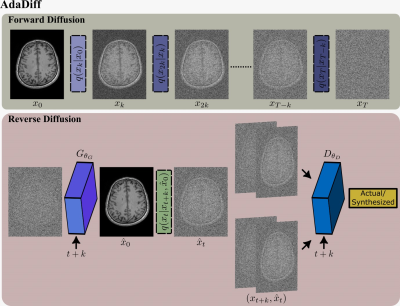 |
Accelerated MRI Reconstruction using Adaptive Diffusion
Probabilistic Networks
Alper Güngör1,2,3,
Salman Ul Hassan Dar1,2,
Şaban Öztürk1,2,4,
Yilmaz Korkmaz1,2,
Gokberk Elmas1,2,
Muzaffer Ozbey1,2,
and Tolga Çukur1,2,5
1Department of Electrical and Electronics Engineering, Bilkent University, Ankara, Turkey, 2National Magnetic Resonance Research Center (UMRAM), Bilkent University, Ankara, Turkey, 3ASELSAN Research Center, Ankara, Turkey, 4Amasya University, Amasya, Turkey, 5Neuroscience Program, Bilkent University, Ankara, Turkey Keywords: Image Reconstruction, Image Reconstruction Learning-based MRI reconstruction is commonly performed using non-adaptive models with frozen weights during inference. Non-adaptive conditional models poorly generalize across variable imaging operators, whereas non-adaptive unconditional models poorly generalize across variations in the image distribution. Here, we introduce a novel adaptive method, AdaDiff, that trains an unconditional diffusion prior for high-fidelity image generations and adapts the prior during inference for improved generalization. AdaDiff outperforms state-of-the-art baselines both visually and quantitatively. |
| 08:15 |
0828.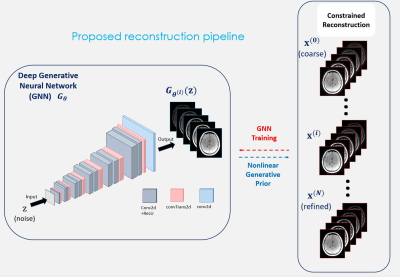 |
Multi-echo MRI Reconstruction with Iteratively Refined
Zero-shot Spatio-Temporal Deep Generative Prior
Tae Hyung Kim1,2,3,
Jaejin Cho2,3,
Borjan Gagoski3,4,
Zijing Dong2,3,
Fuyixue Wang2,3,
So Hyun Kang1,
and Berkin Bilgic2,3,5
1Department of Computer Engineering, Hongik University, Seoul, Korea, Republic of, 2Athinoula A. Martinos Center for Biomedical Imaging, Massachusetts General Hospital, Boston, MA, United States, 3Department of Radiology, Harvard Medical School, Boston, MA, United States, 4Fetal-Neonatal Neuroimaging & Developmental Science Center, Boston Children’s Hospital, Boston, MA, United States, 5Harvard/MIT Health Sciences and Technology, Cambridge, MA, United States Keywords: Image Reconstruction, Brain The subspace method has been widely used for multi-echo/contrast MRI reconstruction, assuming the temporal MR signal evolution can be compactly represented using a few linear coefficients. Recently, methods based on artificial neural networks (trained with large datasets) enabled nonlinear representations of temporal or spatio-temporal MR signals and demonstrated improved performance. This work proposes a novel zero-shot spatio-temporal generative prior for multi-echo/contrast MRI reconstruction, assuming the spatio-temporal MR signals can be nonlinearly generated using deep generative neural networks without external training data. The proposed method was evaluated with 3D-QALAS and EPTI data, and exhibited substantial improvement in NRMSE against existing methods. |
| 08:15 |
0829.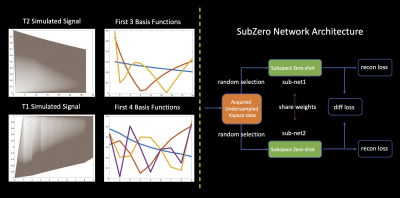 |
SubZero: Subspace Zero-Shot MRI Reconstruction
Heng Yu1,
Yamin Arefeen2,
and Berkin Bilgic3,4
1The Robotics Institute, Carnegie Mellon University, Pittsburgh, PA, United States, 2Department of Electrical Engineering and Computer Science, Massachusetts Institute of Technology, Cambridge, MA, United States, 3Athinoula A. Martinos Center for Biomedical Imaging, Massachusetts General Hospital, Charlestown, MA, United States, 4Department of Radiology, Harvard Medical School, Boston, MA, United States Keywords: Image Reconstruction, Machine Learning/Artificial Intelligence, Deep Learning Recently introduced zero-shot self-supervised learning (ZS-SSL) has shown potential in accelerated MRI in a scan-specific scenario, which enabled high quality reconstructions without access to a large training dataset. ZS-SSL has been further combined with the subspace model to accelerate 2D T2-shuffling acquisitions. In this work, we propose a parallel network framework and introduce attention mechanism to improve subspace based zero-shot self-supervised learning and enable higher acceleration factors. We name our method SubZero and demonstrate that it can achieve improved performance compared with current methods in T1 and T2 mapping acquisitions . |
| 08:15 |
0830.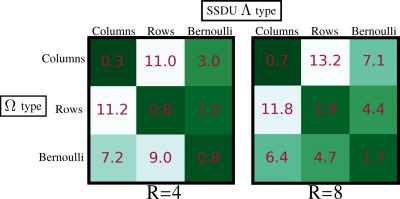 |
Using Noisier2Noise to choose the sampling mask partition of
Self-Supervised Learning via Data Undersampling (SSDU)
Charles Millard1 and
Mark Chiew1
1Wellcome Centre for Integrative Neuroimaging, FMRIB, University of Oxford, Oxford, United Kingdom Keywords: Image Reconstruction, Machine Learning/Artificial Intelligence, Self-supervised learning To train a neural network to recover images with sub-sampled examples only, Self-Supervised Learning via Data Undersampling (SSDU) proposes partitioning the sampling mask into two subsets and training a network to recover one from the other. Recent work on the connection between SSDU and the self-supervised denoising method Noisier2Noise has shown that superior reconstruction quality is possible when the distribution of the partition matches the sampling mask. We test this principle on three types of sampling schemes and find that the test set loss is indeed closest to a fully supervised benchmark when the partition distribution is matched. |
| 08:15 |
0831.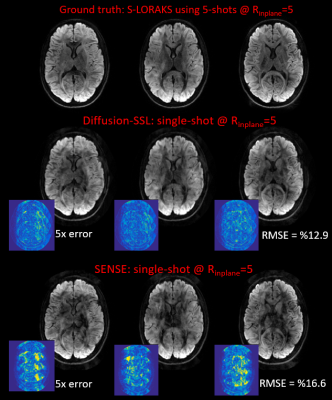 |
Self-Supervised Deep Learning Reconstruction for Highly
Accelerated Diffusion Imaging
Ismail Arda Vurankaya1,
Yohan Jun2,3,
Jaejin Cho2,3,
and Berkin Bilgic2,3
1Electrical and Electronics Engineering, Bogazici University, Istanbul, Turkey, 2Athinoula A. Martinos Center for Biomedical Imaging, Massachusetts General Hospital, Charlestown, MA, United States, 3Department of Radiology, Harvard Medical School, Boston, MA, United States Keywords: Image Reconstruction, Image Reconstruction We propose a zero-shot self-supervised learning (ZS-SSL) approach for accelerated diffusion MRI reconstruction. Our method builds on the approach in [3] for subject-specific MRI reconstruction. We perform reconstruction across all diffusion directions with a single model, rather than different models for each direction, reducing computation time. We partition the directions as training and validation directions. We train the model on training directions, while keeping track of validation loss. We test our model on entire directions, evaluating the reconstruction quality of a single network across all directions. Jointly trained ZS-SSL provides better reconstructions than standard parallel imaging, while remaining computationally efficient. |
| 08:15 |
0832.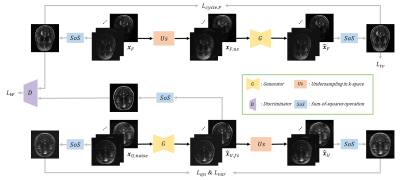 |
A noise-robust accelerated MRI reconstruction using CycleGAN
Seonghyuk Kim1,
Wonil Lee1,
Namho Jeong1,
Jeewon Kim1,
Jongyeon Lee1,
Beomgu Kang1,
and HyunWook Park1
1Korea Advanced Institute of Science and Technology (KAIST), Daejeon, Korea, Republic of Keywords: Parallel Imaging, Machine Learning/Artificial Intelligence, Noise-robust method We propose a novel loss function that increases noise-robustness in accelerated parallel MR image reconstruction. The loss function is based on the variance of the background area in the noisy undersampled image and that of the difference image between noisy undersampled image and the synthesized undersampled image. The proposed loss function provides stronger regularization and robustness when applied along with other constraints. We show that the application of the proposed loss function boosts performance of the network, yielding improved quality of reconstructed image. |
| 08:15 |
0833. |
SVD Compression for Nonlinear Encoding Imaging with
Model-based Deep Learning Reconstruction
Zhehong Zhang1,
Kartiga Selvaganesan1,
Yonghyun Ha2,
Chenhao Sun2,
Anja Samardzija1,
Heng Sun1,
Gigi Galiana1,2,
and R. Todd Constable1,2,3,4
1Department of Biomedical Engineering, School of Engineering and Applied Science, Yale University, New Haven, CT, United States, 2Department of Radiology and Biomedical Imaging, School of Medicine, Yale University, New Haven, CT, United States, 3Interdepartmental Neuroscience Program, School of Medicine, Yale University, New Haven, CT, United States, 4Department of Neurosurgery, School of Medicine, Yale University, New Haven, CT, United States Keywords: Image Reconstruction, Signal Representations, Nonlinear Encoding Model-based deep learning reconstruction with a nonlinear encoding matrix poses unique challenges to GPU memory, due to the densely connected computational graph nodes in the physics model part. In this work, SVD compression is demonstrated as necessary for such networks, and it is applied to the highly nonlinear case of Bloch-Siegert encoding from a low-field MR scanner. The redundancy across all nonlinear encoding dimensions is exploited for compression. With the compressed encoding matrix, the model-based network is feasible to implement. It outperforms the traditional reconstruction at all levels of simulated Gaussian noise and has advantages over commonly used regularization terms. |
| 08:15 |
0834. |
NPB-REC: Non-parametric Assessment of Uncertainty in
Deep-learning-based MRI Reconstruction from Undersampled
Data
Samah Khawaled1 and
Moti Freiman 2
1The Interdisciplinary Applied mathematics Program, Technion, Haifa, Israel, 2Faculty of Biomedical Engineering, Technion, Haifa, Israel Keywords: Image Reconstruction, Machine Learning/Artificial Intelligence Deep learning (DL) models are currently employed to reconstruct high quality MRI image from undersampled k-space measurements. Yet, uncertainty quantification in images reconstructed by such models is critical for reliable clinical decision making. We propose NPBREC, a non-parametric Bayesian approach for uncertainty estimation in DL-based MRI reconstruction. We demonstrated the added-value of our Bayesian registration framework on the fastmri multi-coil brain MRI dataset, compared to the baseline E2E-VarNet trained with and without inference-time dropout for uncertainty quantification. Our NPBREC approach demonstrated both improved reconstruction accuracy and a better correlation between reconstruction errors and uncertainty measures. |
| 08:15 |
0835. |
DeepSTI: Towards Tensor Reconstruction using Fewer
Orientations in Susceptibility Tensor Imaging
Zhenghan Fang1,
Kuo-Wei Lai1,
Peter van Zijl1,
Xu Li1,
and Jeremias Sulam1
1The Johns Hopkins University, Baltimore, MD, United States Keywords: Image Reconstruction, Susceptibility, Susceptibility Tensor Imaging The application of STI in human in vivo has been practically infeasible because of its time-consuming acquisition scheme. We propose a novel image reconstruction algorithm for STI that leverages data-driven priors to tackle this issue. Our method, called DeepSTI, learns the data prior implicitly via a deep neural network that resembles the proximal operator of a regularizer function. The dipole inversion problem is then solved iteratively using the learned proximal network. Experimental results demonstrate superior performance of DeepSTI over state-of-the-art methods. DeepSTI is the first reconstruction method to achieve high quality results for human STI with fewer than six orientations. |
| 08:15 |
0836.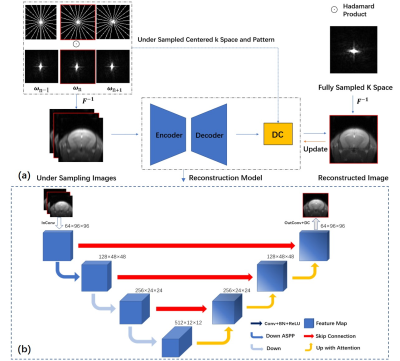 |
Attention-Based Multi-Offset Deep Learning Reconstruction
for Accelerating Chemical Exchange Saturation Transfer MRI
Zhikai Yang1,2,
Liu Yang1,2,
Rohith Saai Pemmasani Prabakaran2,
AbdulMojeed Olabisi ILYAS2,
Jianpan Huang1,
and Kannie W. Y. Chan1,2,3,4,5
1Department of Biomedical Engineering, City University of Hong Kong, Hong Kong, Hong Kong, 2Hong Kong Centre for Cerebro-Cardiovascular Health Engineering (COCHE), Hong Kong, Hong Kong, 3City University of Hong Kong Shenzhen Research Institute, Shenzhen, China, 4Russell H. Morgan Department of Radiology and Radiological Science, The Johns Hopkins University School of Medicine, Baltimore, MD, United States, 5Tung Biomedical Sciences Centre, City University of Hong Kong, Hong Kong, Hong Kong Keywords: Image Reconstruction, Machine Learning/Artificial Intelligence We proposed an attention-based multi-offset network to exploit redundant anatomy information for the reconstruction of CEST-MR image (AMO-CEST). To the best of our knowledge, this is the first work using deep learning with varied radial sample patterns and multi-offset slices as input to accelerate CEST-MRI. Compared with other deep learning-based methods on the four times under-sampling mouse brain CEST dataset, the AMO-CEST achieved the best performance with an MMSE of , a PSNR of dB, and an SSIM . In conclusion, the proposed AMO-CEST network can accelerate the CEST-MRI at high down-sampling rate while maintaining good image quality. |
| 08:15 |
0837.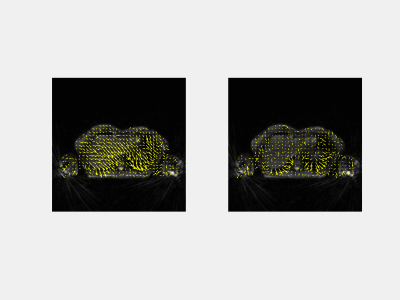 |
Investigating VoxelMorph Image Registration for Fast 4D
Respiratory Compensated Image Reconstruction on an MR-Linac
Rosie Goodburn1,
Movindu Dassanayake2,
Bastien Lecoeur1,
Prashant Nair1,
Uwe Oelfke1,
and Andreas Wetscherek1
1Institute of Cancer Research, London, United Kingdom, 2Imperial College London, London, United Kingdom Keywords: Image Reconstruction, Radiotherapy Respiratory resolved (4D)-MRI is expected to benefit MRI-guided radiotherapy for abdominal-thoracic cancers. However, a current limitation of 4D-MRI is that one has to trade-off between artefacts, spatial-temporal resolution, and spatial coverage. Deformable image registration has been employed to enhance image quality of undersampled 4D-MRIs, but such approaches are usually too slow to be used in MR-guided radiotherapy workflows. We investigated the feasibility of employing models trained using the VoxelMorph framework with a view of leveraging a fast computation to minimise 4D-MRI reconstruction time on the MR-Linac. The models performed well and were ~48 times faster than a common registration method. |
| 08:15 |
0838.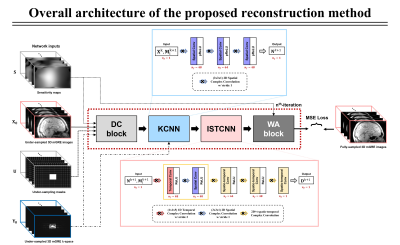 |
Accelerated 3D Myelin Water Imaging: Jointly Unrolled
Cross-domain Optimization-based Spatio-Temporal
Reconstruction Network
Jae-Hun Lee1,
Dongyeob Han2,
Jae-Yoon Kim1,
and Dong-Hyun Kim1
1Department of Electrical and Electronic Engineering, Yonsei Univ., Seoul, Korea, Republic of, 2Siemens Healthineers Ltd, Siemens Korea, Seoul, Korea, Republic of Keywords: Parallel Imaging, Image Reconstruction, Quantitative Imaging, White Matter Recently, acceleration of 3D multi-echo gradient-echo (mGRE) acquisition for myelin water imaging (MWI) has been achieved using parallel imaging (PI) or deep learning network. However, these methods typically allow a low acceleration factor (R) for MWI because of the high sensitivity of the MWI estimation routine with respect noise/artifacts. Here, we developed a reconstruction deep learning network called the jointly unrolled cross-domain optimization-based spatio-temporal reconstruction network. According to retrospective and prospective reconstruction results, the proposed method achieved high-fidelity performance on the reconstructed mGRE images and MWI maps. |
The International Society for Magnetic Resonance in Medicine is accredited by the Accreditation Council for Continuing Medical Education to provide continuing medical education for physicians.